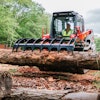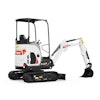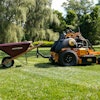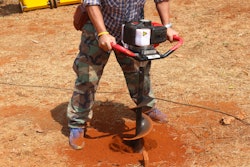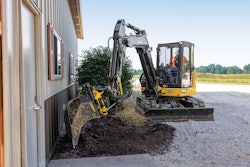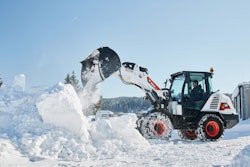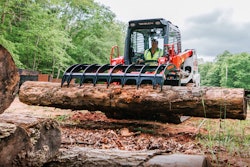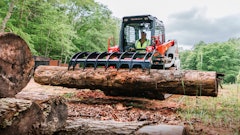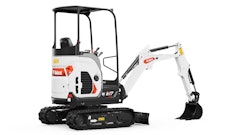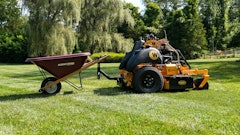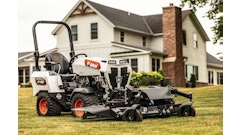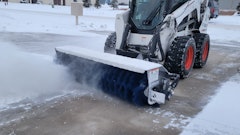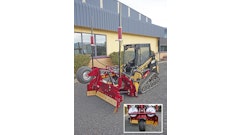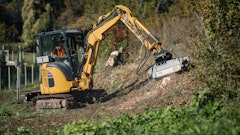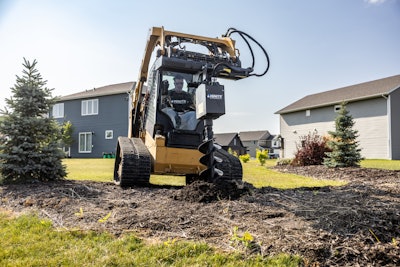
With the right lineup of attachments, you can turn your compact equipment into a Swiss army knife for the jobsite. Mix and match your attachment lineup to maximize your productivity, efficiency and budget with these considerations.
Do more with less
There are a few different ways to maximize your capabilities with attachments.
First, add versatility. Look for tools that can tackle multiple jobs, whether that’s a grapple, a mower, an auger or any other attachment. While the tool might not be perfect for every job, the less you have to stop and change attachments during the day, the better your overall efficiency.
Grapples, for example, are a great addition to a landscape contractor’s fleet. The combination of bucket and clam shell grapples makes it easy to dig, grab, pull and haul material. Some popular grapple options include:
- Industrial grapple buckets: a flat, closed-bottom bucket with a dual independent grapple used to move materials like dirt, gravel, debris, logs and firewood and to efficiently clear scrap from jobsites and other flat areas
- Rock grapples: a rock bucket with closely placed tines, typically between 2 to 4 inches apart, made to scoop and clear rocks
- Root grapples: an open bottom design that allows dirt to fall through, with slightly wider set tines, typically 5 to 8 inches, used to dig out roots and stumps and sift material. Root grapples are perfect for penetrating the ground, ripping up roots and leaving a clear surface behind
Alternatively, look for value attachments that will allow you to expand your offerings without a significant upfront investment. For example, would adding an auger attachment open up new opportunities for you and your team? With the right drive system you can dig through most soil profiles, and an assortment of bits gives you flexibility to take on a wide variety of landscape and hardscape applications. What about a cement chute bucket? These simple attachments make it easy to pour concrete in tight spaces with a compact track loader. They also minimize the need for a third-party cement supplier, allowing you to work on your timeline, not the pump truck’s.
So, whether you’re looking for one attachment to do all the things or a specialty tool to increase your capabilities, you’ll get the best results if you do your homework. Consider things like laser-cut, robot-welded steel, flat faced couplers that connect under pressure, hose protection, and overall ease of maintenance. One or two well-utilized tools can provide excellent ROI and a long useful life, if they’re well built.
Maximize your carrier’s capabilities.
With any attachment, you want to make sure your tool matches the capabilities of your carrier. This includes width, weight and any hydraulic requirements. Your equipment dealer can help you spec the right attachment for your existing equipment. You can also find free online tools that are available 24 hours a day, seven days a week. This user-friendly tool uses tens of thousands of data points to determine compatibility across most makes and models of compact tractors, skid-steer loaders, compact track loaders and mini excavators from all major manufacturers.
Something to keep in mind as you’re comparing specs is that bigger doesn’t always mean better in the world of attachments. The same goes for more expensive. While it might seem that a heavier attachment equals more durability, that isn’t always the case. A heavier attachment can eat into your lifting capacity. Look for manufacturers that use FEA testing and smart engineering to provide the perfect balance between weight and strength. This type of testing uses computer models to identify potential weak spots. Engineers can then add strengthening components only in those locations for maximum strength with minimal weight. By reserving more of the carrier's rated operating capacity for lifting and transporting heavy materials, operators can lift more and do more. This also allows operators to use larger attachments with smaller equipment in some cases.
Along the same line, make sure you’re not overinvesting when it comes to the attachment’s duty level. For example, if you’re hauling concrete, rocks or hazardous debris, a severe-duty bucket is probably worth the additional pounds and dollars. However, most landscape professionals can get away with a well-built regular duty bucket for 99 percent of their applications.
Think it through
Once you’ve purchased the right attachment lineup, it’s time to put your new tools to work. To minimize downtime on the jobsite, be sure to carefully think through which tools you’ll need and in what order. For example, is there a way to do all the bucket work before you switch to a sweeper? It won’t always work out that way, but going into the job with a plan can help keep your team and your equipment productive.
